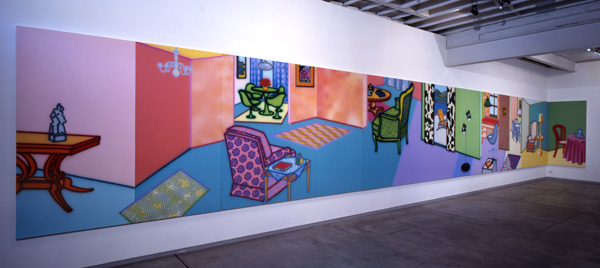Fabricated Rooms (1997-99)

(i) 1997 form: Synthetic polymer paint on 13 canvasses, 203 x 1400 overall
(ii) Final (1999) form: Synthetic polymer paint on 17 canvases, 203 x 1930 overall
Corbett Lyon and Yueji Lyon Collection of Contemporary Australian Art, Melbourne
The original installation was shown at the Art Gallery of New South Wales late in 1997, and then in Benalla (April 1998) and Tolarno (Nov.-Dec.1998), in each case with one or both ends wrapped round an adjoining wall. (The photo reproduced here shows the Tolarno installation.)
The second, considerably enlarged version of the work (incorporating four new canvases) was unveiled in Venice, as the centrepiece of Arkley’s 1999 Biennale ‘Home Show’, installed in a U form on three walls of the lower space of the Australian Pavilion (for photo and discussion, see 1999).
On its first showing in Sydney, the work attracted insightful comment (notably by O’Connell 1997 and Zepke 1998) and a vigorous critical response from Sydney Morning Herald critic John McDonald (1997), all three writers focussing on the work’s strangely empty, shifting space. Relatively damning in his comments (the ‘graphic style gives the impression of obsessive, febrile activity’, he insisted), McDonald also succeeded in taking a swipe at a number of major mid-career Australian artists not to his taste, with his observation that Arkley nevertheless ‘remains a far more interesting artist than those who are put forward as his boon companions, notably John Nixon…’ (etc.).
Mathew Jones, commenting on the Tolarno exhibition of the work (Herald Sun 30/11/98), quoted Arkley’s intention to expand the work in the future (mentioning a ‘companion piece’), to produce a ‘total environment’ along the lines of James Rosenquist’s famous Pop installation F-111 (1965). Arkley did go a considerable way towards realising this grand ambition in the expanded version shown in Venice, which, as noted in Carnival 35, at almost 2 x 20 metres, is almost as large as Rosenquist’s work (about 3 x 26 m).
But, as Arkley was well aware, the monumental scale of the work is undercut to a large extent by its banal subject-matter (again, based largely on the templates in Gold’s Instant Decorator). The result is an installation whose optical and spatial ambiguities are matched by an apparently vacillating tone, thus bamboozling a number of viewers and critics, notably Peter Timms (2000).
In 2009, the work was installed in a dedicated space in the new Lyon Housemuseum in the Melbourne suburb of Kew. In an article published in Art & Australia to mark the opening of this major new private museum, architect and patron Corbett Lyon made several illuminating comments on Fabricated Rooms (see Fitzgerald 2010: esp. 412 and 415):
“When Arkley showed it at the 1999 Venice Biennale he spoke about further extending the work to become a complete in-the-round experience. We also talked about creating a purpose-built room with a single entry door to exhibit it in. Unfortunately this never happened due to his untimely death soon after Venice.”
For further analysis and comment, see in particular Engberg 1999, Livingstone & Morrell 1999, Spray (rev.ed., 2001), and Carnival 32ff.
Provenance
- acquired directly via Tolarno, 1997/1999
Exhibited
- Art Gallery of New South Wales, Sydney, 9/11/97-5/1/98 (‘Howard Arkley: Fabricated Rooms’)
- Benalla Art Gallery, from 3/4/98 (‘Howard Arkley: Fabricated Rooms’)
- HA Tolarno 11/98 (Fabricated Rooms and ‘Sampling’)
- HA Venice 1999 (‘The Home Show’)
- Ian Potter Gallery, Uni.Melb., Jan.-Feb.2000 (‘HA: The Home Show’)
- HA retrospective 2006-7 (shown in all 3 venues)
Literature
- McDonald 1997
- O’Connell 1997
- Jones 1998
- Zepke 1998
- Engberg 1999
- Livingstone & Morrell 1999 (HA Venice exh.cat.), passim
- Timms 2000
- Spray [rev.edn., 2001], 130ff. (inc.ill.of 1997 AGNSW installation)
- Carnival 32-39 and Figs.1.22, 3.24, 4.11
- NGVA Arkley audio-guide 2006 (comments by Jason Smith and Ashley Crawford)
- Fitzgerald 2010 (quoted above)